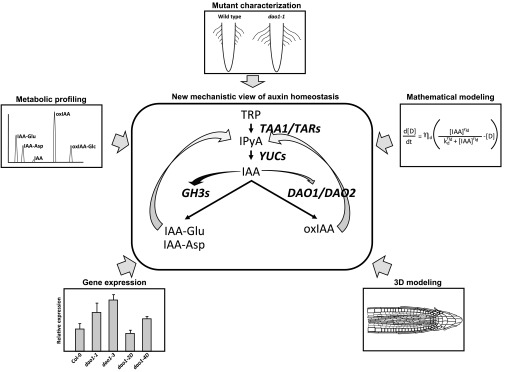Fig. 1.
Schematic representation of the main routes of auxin metabolism and the new interactions found between anabolic and catabolic pathways. In the central panel, the indole-3-pyruvic acid (IPyA) route of auxin biosynthesis from tryptophan (TRP) to indole-3-acetic acid (IAA) is depicted, as well as the two main routes of auxin inactivation, the conjugation of IAA to glutamate (IAA-Glu) and aspartate (IAA-Asp), and the oxidation of IAA to 2-oxindole-3-acetic acid (oxIAA). The genes coding for the enzymes involved in the depicted enzymatic conversions are shown in bold italic letters. Straight arrows indicate the conversion of a precursor into a product. Curved arrows indicate regulatory interactions. The arrows converging on IPyA mark the feedback on IAA biosynthesis by a yet-undetermined molecular mechanism. The curved arrows originating from IAA signify the quick and strong stimulatory effect of high levels of IAA on GH3 activity (dark curved arrow) or a slow and weak induction of DAO1 by IAA (gray curved arrow) via transcriptional up-regulation of the respective genes. The peripheral panels depict some of the strategies used in the studies by Zhang et al. (5), Porco et al. (6), and Mellor et al. (7) to uncover the new mechanisms of auxin homeostasis.

